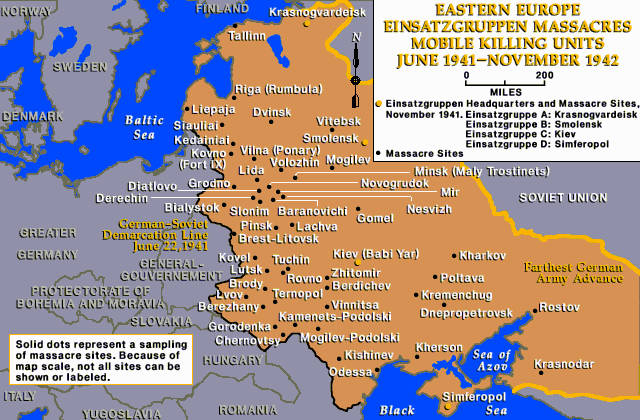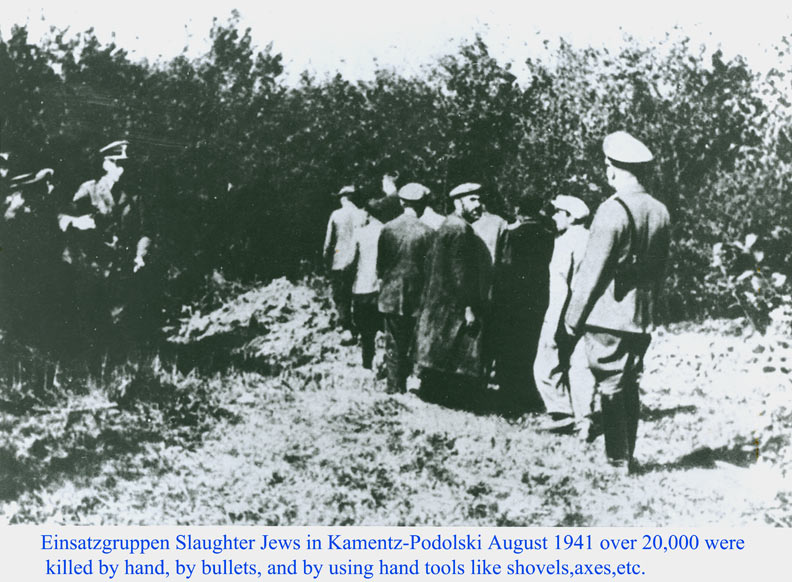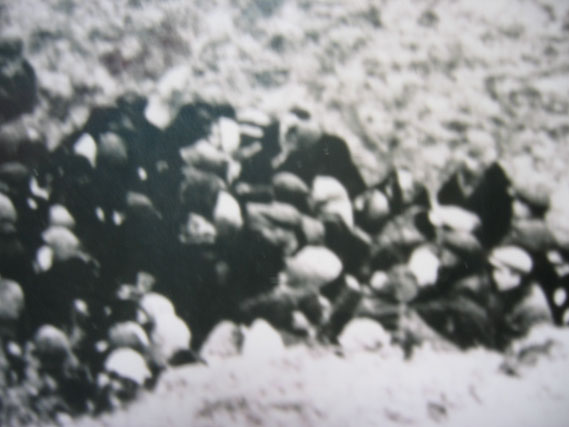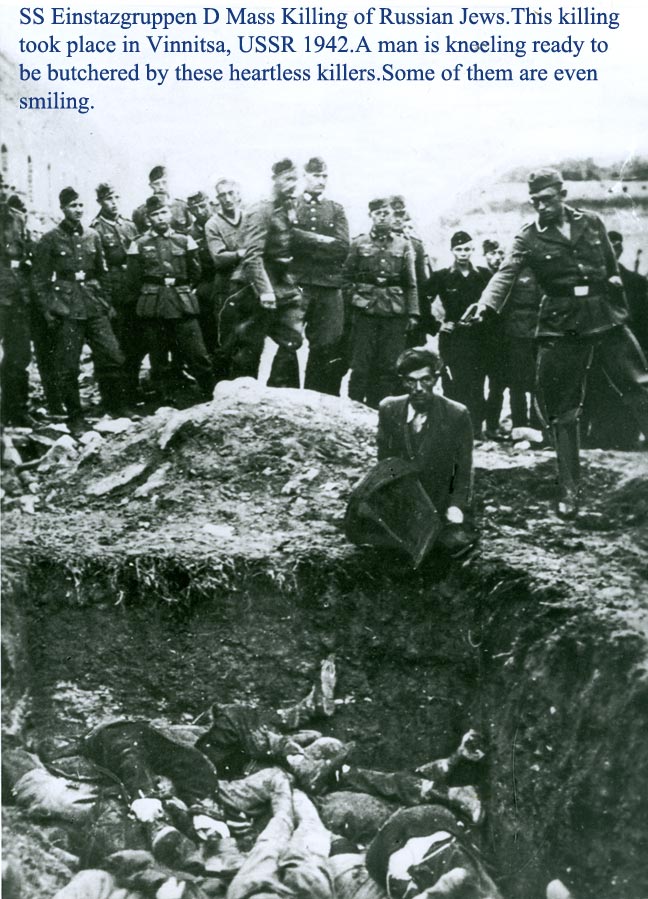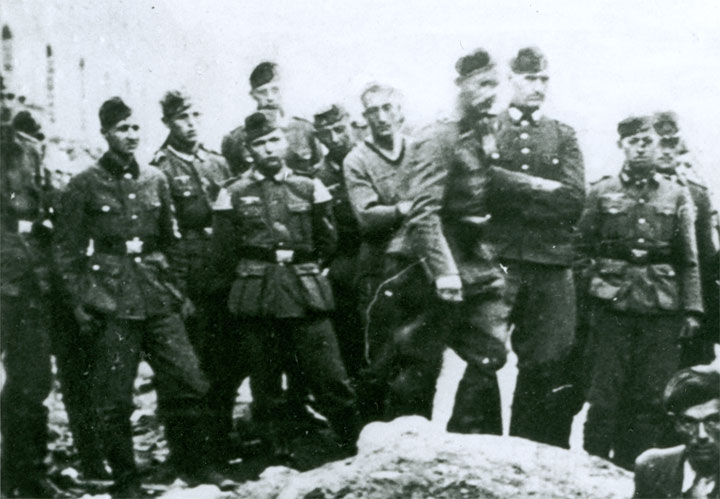|
To go back to Page One of Memorial Click This Link
Here
The Einsatzgruppen were four paramilitary units established before the invasion of the Soviet Union for the purpose of "liquidating" (murdering) Jews, Romany, and political operatives of the Communist party. Ultimately three of these groups (Einsatzgruppen A, B. and C) were attached to army groups taking part in the invasion. A fourth group (Einsatzgruppe D) was sent to the Ukraine without being attached to any army group. All operated in the territories occupied by the Third Reich on the eastern front. Most of the crimes perpetrated by the Eisnsatzgruppen took place in the Ukraine and the Baltic states of Latvia, Estonia and Lithuania. Einsatzgruppen Units followed behind the Army and after the region was occupied then they would arrive. After negotiations with the German army conducted between Eduard Wagner, the Quartermaster of the Army, and Heydrich, it was agreed that in the front lines the Einsatzgruppen would be under army control but that in the operations area and in the rear areas the army's authority would not extend beyond tactical matters. (Harris, p. 176-7, IMT III, 246,290) Ohlendorf was one of the particiants at ths meeting. In effect the Einsatzgruppen were almost always operationally independent taking their orders directly from Heinrich Himmler and, until his death, Reinhard Heydrich. While there were plans to establish similar units in other territories controlled by the Nazis (Ohlendorf; Nuremberg testimony), these plans were never implemented. This was not the first time that "Einsatzgruppen" were used by the Third Reich. During the invasion of Poland in 1939, similar units, also known as "Einsatzgruppen" accompanied the invading armies and performed similar tasks such as the arrest or "liquidation" of priests and other Polish intelligentsia. They were not, however, given a task of mass murder like that carried out by the Einsatzgruppen during the invasion of the Soviet Union. The Einsatzgruppen who took part in the invasion of the Soviet Union were new units, formed and trained immediately before that invasion with no organizational history connecting them to the Einsatzgruppen that existed during the invasion of Poland. The Purpose of the Einsatzgruppen The most succinct description of the purpose of the Einsatzgruppen was given at the trial of Adolph Eichmann by Dr. Michael Musmanno, Justice of the Pennsylvania Supreme Court, who presided over the trial of 23 of the leaders of the Einsatzgruppen. He stated "The purpose of the Einsatzgruppen was to murder Jews and deprive them of their property." SS General Erich von dem Bach-Zelewski confirmed this at the main Nuremberg Trial when he testified that "The principal task [of the Einsatzgruppen] was the annihilation of the Jews, gypsies, and political commissars."
The Victims of the Einsatzgruppen The overwhelming proportion of the men, women, and children murdered by the Einsatzgruppen were Jews. The Einsatzgruppen also murdered Romany (gypsies), those identified as functionaries of the Communist Party, those accused of defying the occupying armies of the Third Reich, and those accused of being partisans or guerilla fighters against the invading armies. In all cases the murders were contrary to accepted law. Although an exact figure will never be known, approximately 1,500,000 people were murdered by the Einsatzgruppen. The Einsatzgruppen submitted detailed and specific reports of their actions to their superiors both by radio and written communication; these reports were checked against each other for accuracy at Heydrich's headquarters. According to those reports approximately 1,500,000 people were murdered. In evaluating this large number Justice Michael Musmanno, who presided at the trial of the Einsatzgruppen wrote:
The Best Evidence of the Crimes of the Einsatzgruppen The reports of the Einsatzgruppen which report in detail their murder and robbery are the best evidence that we have of what the Einsatzgruppen did. When the U.S. Army captured the headquarters of the Gestapo they found hundreds of written reports from the Einsatzgruppen dispassionately listing their activities. There are two kinds of reports in the collection. "Activity and Situation Reports" (or "Situation Reports") were monthly compilations of the activities of all of the Einsatzgruppen. "Operational Situation Reports" (or "Operational Reports") were detailed reports from the various units giving, in precise detail, the number of murders committed and the property stolen. These reports were sequentially numbered and all but one of the Operational Situation Reports were found in the archives of the Third Reich. The originals of these reports are currently held by the German government in the archive at Coblentz where they are available to researchers and historians. These reports give us a complete picture of what the Einsatzgruppen were doing and, since they were approved by the highest authorities of the Third Reich, represent the best evidence of the orders given to the Einsatzgruppen. The reports are shocking both in their scope and the callous attitudes they display towards mass murder. One of the judges hearing the appeal in the Stelmokas case had a typical reaction to the contents of one report: "Colonel Jaeger reports the executions of thousands of Jews and hundreds of others in such an impersonal, matter-of-fact-manner and with such pride that his account leaves one in a horror-driven state of shock." (100 F.3rd 302, 325) Additionally direct evidence was presented in two trials. The first was the trial of Otto Ohlendorf, commander of Einsatzgruppe D, and 22 other members of the SS charged with responsibility for the crimes of the Einsatzgruppen. Justice Michael Musmanno of the Pennsylvania Supreme Court presided at the trial with legendary equity. He allowed the defendants every leeway in presenting a defense to their actions. He found that it was beyond a reasonable doubt that, based on the evidence presented, that all of the defendants were guilty as charged. Fourteen of the defendants were sentenced to death.
The Einsatzgruppen did not act alone. They had help. The Einsatzgruppen could call on the Wehrmacht for assistance but far more important were local militia groups willing to cooperate in the massacres. At Babi Yar where 33,771 Jews were murdered on September 29-30, 1941, there were two Ukrainian "kommandos" assisting Sonderkommando 4a. In Lithuania Operational Report 19 (July 11, 1941) states that "We have retained approximately 205 Lithuanian partisans as a Sonderkommando, sustained them and deployed them for executions as necessary even outside the area." In the Ukraine the Einsatzgruppen frequently welcomed the participation of local militia both because they needed the help of these auxiliaries but because they hoped to involve the locals in the pogrom they were conducting. (Operational Report 81, from Einsatzkommando 6, September 12, 1941) There are many known instances of these local militias assisting the Einsatzgruppen. During the "Gross Aktion" of October 28-29, 1941, at Kaunas in Lithuania during which 9,200 Jews were murdered, Lithuanian militia worked with the Einsatzgruppen. (100 F.3rd at 308) Other examples are Zhitomir on September 18, 1941, in the Ukraine where 3,145 Jews were murdered with the assistance of Ukrainian militia (Operational Report 106) and Korosten where Ukrainian militia rounded up 238 Jews for liquidation (Operational Report 80). At times the assistance was more active. Operational Report 88, for example, reports that on September 6, 1941, 1,107 Jewish adults were shot while the Ukrainian militia unit assisting them liquidated 561 Jewish children and youths. In many cases the militia that assisted the Einsatzgruppen were paid from the money and valuables stolen from the victims.
The Methods of the Einsatzgruppen The Einsatzgruppen shot people. It's as simple as that. Using various pretexts they rounded up their victims, transported them to a central killing ground and shot them. At Babi Yar the Jews of Kiev were informed by placards posted around the city by Ukrainian militia for Jews to assemble at 8:00 a.m. on September 29, 1941, at a cemetery near a railroad siding for "resettlement." They were told to bring with them food, warm clothing, documents, money, and valuables. (Dawidowicz, What, 103-4). The scene was described by one officer at his trial in 1967. He stated "It was like a mass migration . . . the Jews sang religious songs on the way." At the railroad siding their food and belongings were taken from them and:
After this brutal processing, the victims were lined up at edge of the ravine and gunned down by teams of machine gunners. By the time they were finished on Spetember 30, 1941, 33,700 people had been killed. Otto Ohlendorf testified about the methods used both at his own trial and the trial of the leaders of the Third Reich at Nuremberg. At Nuremberg he told the court that Jews were gathered for mass murders "on the pretext that they were to be resettled." He then told the Tribunal: "After the registration the Jews were collected at one place; and from there they were later transported to the place of execution, which was, as a rule, an antitank ditch or natural excavation. The executions were carried out in a military manner, by firing squads under command." Not all of the groups committed their murders with the military precision of Ohlendorf's. As he testified "Some of the unit leaders did not carry out liquidations in the military manner, but killed the victims singly by shooting them in the back of the neck." After December, 1941, the nazis experimented with vans designed by Dr. Becker using lethal gas, exhaust from the motors. Not only was this method slow but, according to Otto Ohlendorf, it was not popular with his men because "the unloading of the corpses was an unnecessary mental strain." Almost all of the victims of these experiments were women and children and, throughout the Einsatzgruppen's reign of terror, shooting was the primary means of execution.
Photographic Evidence Of Einsatzgruppen Slayings The next series of photos were all taken in 1941-42 and will show the Einsatzkommando Killing Squads doing their infernal work of slaughtering innnocent people.These pictures were all taken in the Ukraine as the German Army advanced thru Russia.These Jewish men are about to be shot and they are being led into the woods by a German Soldier.
This execution took place in the Ukraine.Here you can see the vast amount of people about to be shot by German Soldiers.
A closeup of some of the soldier's who attended this killing in Vinnitsa.
|
